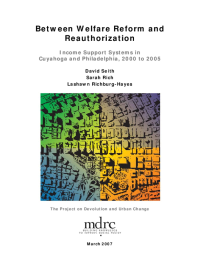Between Welfare Reform and Reauthorization
Income Support Systems in Cuyahoga and Philadelphia, 2000 to 2005
In 1996, Congress passed and President Clinton signed federal welfare reform legislation, replacing the nation’s primary welfare program, Aid to Families with Dependent Children (AFDC), with a new program called Temporary Assistance for Needy Families (TANF). Designed to replace an entitlement with a temporary benefit, TANF transformed the nation’s welfare program in several important ways: It gave states annual, fixed block grants that offered them greater flexibility to design and administer their own welfare programs; it created a five-year lifetime limit on receipt of cash assistance; and it required recipients to work and called for states to impose sanctions (financial penalties) on those recipients who did not.
Anticipating that welfare reform might pose particular challenges to urban areas — where poverty and welfare receipt are most concentrated — MDRC launched the Project on Devolution and Urban Change (Urban Change, for short) in 1997 to chronicle TANF programs and the resulting changes in the lives of low-income families and in the institutions that serve them in four urban counties: Cuyahoga (Cleveland), Los Angeles, Miami-Dade, and Philadelphia. Between 2002 and 2005, MDRC released reports on each of the four cities to tell the stories of welfare reform up until 2001. These reports found four different approaches to welfare reform but remarkably similar results. In all four counties, welfare caseloads were down; conditions improved in high-poverty and high-welfare neighborhoods; and welfare recipients who were surveyed at two points in time were more likely to be working and to be financially better off in 2001 than in 1998, even though most remained poor.
This report updates the story of welfare reform in two of the four Urban Change cities: Cleveland and Philadelphia. As it turned out, the 1990s represented the best environment in which to implement welfare reform. Poverty rates among children reached record lows during the decade, and employment levels among single-parent women reached a record high. By March 2001, the national economy fell into a recession that would officially last eight months, although employment continued to decline through August 2003. Welfare-to-work budgets and civil service workforces were scaled back in response to state budget deficits. It was during this period of job losses and budget deficits that families started reaching the federal five-year time limit on cash assistance, in 2002.
How have state service delivery systems evolved as a result of these changing conditions? And how have the longer-term effects of welfare reform played out in caseload dynamics and in social and health indicators in low-income neighborhoods? To address these questions, this report extends three sets of analyses from the earlier Urban Change studies of Cleveland and Philadelphia: An implementation analysis examines the policies and programs that welfare agencies put into place through 2005; an analysis of administrative records estimates the effects of welfare reform on caseload trends in welfare receipt and employment through 2003 for Cleveland and through 2001 for Philadelphia; and a neighborhood indicators analysis describes the changing conditions of low-income communities through 2003.






